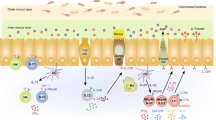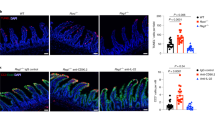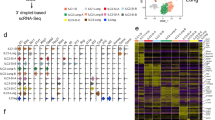Abstract
Mucosal tissues, lying at the interface with the external environment, are constantly challenged by microbial, physical and chemical assaults. To provide the necessary immune defence to such challenges, lymph nodes and Peyer's patches are formed in utero in response to inductive signals from lymphoid-tissue inducer (LTi) cells. As discussed in this Progress article, a series of recent reports has identified a population of interleukin-22-producing mucosal cells in the gut and tonsils that share features with both LTi cells (by expressing RORγt) and natural killer cells (by expressing NKp46) and that might be involved in immunity and homeostasis in mucosal tissues.
This is a preview of subscription content, access via your institution
Access options
Subscribe to this journal
Receive 12 print issues and online access
$209.00 per year
only $17.42 per issue
Buy this article
- Purchase on Springer Link
- Instant access to full article PDF
Prices may be subject to local taxes which are calculated during checkout


Similar content being viewed by others
References
Mebius, R. E. Organogenesis of lymphoid tissues. Nature Rev. Immunol. 3, 292–303 (2003).
Mebius, R. E., Rennert, P. & Weissman, I. L. Developing lymph nodes collect CD4+CD3−LTβ+ cells that can differentiate to APC, NK cells and follicular cells but not T or B cells. Immunity 7, 493–504 (1997).
Sun, Z. et al. Requirement for RORγ in thymocyte survival and lymphoid organ development. Science 288, 2369–2373 (2000).
Eberl, G. et al. An essential function for the nuclear receptor RORγt in the generation of fetal lymphoid tissue inducer cells. Nature Immunol. 5, 64–73 (2004).
Yokota, Y. et al. Development of peripheral lymphoid organs and natural killer cells depends on the helix-loop-helix inhibitor Id2. Nature 397, 702–706 (1999).
Kanamori, Y. et al. Identification of novel lymphoid tissues in murine intestinal mucosa where clusters of c-kit+IL-7R+Thy1+ lympho-hemopoietic progenitors develop. J. Exp. Med. 184, 1449–1459 (1996).
Naito, T., Shiohara, T., Hibi, T., Suematsu, M. & Ishikawa, H. RORγt is dispensable for the development of intestinal mucosal T cells. Mucosal Immunol. 1, 198–207 (2008).
Yoshida, H. et al. Expression of α4β7 integrin defines a distinct pathway of lymphoid progenitors committed to T cells, fetal intestinal lymphotoxin producer, NK, and dendritic cells. J. Immunol. 167, 2511–2521 (2001).
Cupedo, T. et al. Presumptive lymph node organizers are differentially represented in developing mesenteric and peripheral nodes. J. Immunol. 173, 2968–2975 (2004).
Tsuji, M. et al. Requirement for lymphoid tissue-inducer cells in isolated follicle formation and T cell-independent immunoglobulin A generation in the gut. Immunity 29, 261–271 (2008).
Kim, M. Y. et al. Heterogeneity of lymphoid tissue inducer cell populations present in embryonic and adult mouse lymphoid tissues. Immunology 124, 166–174 (2008).
Takatori, H. et al. Lymphoid tissue inducer-like cells are an innate source of IL-17 and IL-22. J. Exp. Med. 206, 35–41 (2009).
Scandella, E. et al. Restoration of lymphoid organ integrity through the interaction of lymphoid tissue-inducer cells with stroma of the T cell zone. Nature Immunol. 9, 667–675 (2008).
Cupedo, T. et al. Human fetal lymphoid tissue-inducer cells are interleukin-17-producing precursors to RORC+CD127+ natural killer-like cells. Nature Immunol. 10, 66–74 (2009).
Ivanov, I. I. et al. The orphan nuclear receptor RORγt directs the differentiation program of proinflammatory IL-17+ T helper cells. Cell 126, 1121–1133 (2006).
Dong, C. TH17 cells in development: an updated view of their molecular identity and genetic programming. Nature Rev. Immunol. 8, 337–348 (2008).
Ivanov, I. I. et al. Specific microbiota direct the differentiation of IL-17-producing T-helper cells in the mucosa of the small intestine. Cell Host Microbe 4, 337–349 (2008).
Ouyang, W., Kolls, J. K. & Zheng, Y. The biological functions of T helper 17 cell effector cytokines in inflammation. Immunity 28, 454–467 (2008).
Luci, C. et al. Influence of the transcription factor RORγt on the development of NKp46+ cell populations in gut and skin. Nature Immunol. 10, 75–82 (2009).
Sanos, S. L. et al. RORγt and commensal microflora are required for the differentiation of mucosal interleukin-22-producing NKp46+ cells. Nature Immunol. 10, 83–91 (2009).
Cella, M. et al. A human natural killer cell subset provides an innate source of IL-22 for mucosal immunity. Nature 457, 722–725 (2009).
Satoh-Takayama, N. et al. Microbial flora drives interleukin-22 production in intestinal NKp46+ cells that provide innate mucosal immune defense. Immunity 29, 958–970 (2008).
Moretta, A., Biassoni, R., Bottino, C., Mingari, M. C. & Moretta, L. Natural cytotoxicity receptors that trigger human NK-cell-mediated cytolysis. Immunol. Today 21, 228–234 (2000).
Moretta, L. & Moretta, A. Unravelling natural killer cell function: triggering and inhibitory human NK receptors. Embo J. 23, 255–259 (2004).
Mandelboim, O. et al. Recognition of haemagglutinins on virus-infected cells by NKp46 activates lysis by human NK cells. Nature 409, 1055–1060 (2001).
Walzer, T., Jaeger, S., Chaix, J. & Vivier, E. Natural killer cells: from CD3−NKp46+ to post-genomics meta-analyses. Curr. Opin. Immunol. 19, 365–372 (2007).
Walzer, T. et al. Identification, activation, and selective in vivo ablation of mouse NK cells via NKp46. Proc. Natl Acad. Sci. USA 104, 3384–3389 (2007).
Meresse, B. et al. Reprogramming of CTLs into natural killer-like cells in celiac disease. J. Exp. Med. 203, 1343–1355 (2006).
Vivier, E. & Anfossi, N. Inhibitory NK-cell receptors on T cells: witness of the past, actors of the future. Nature Rev. Immunol. 4, 190–198 (2004).
Diefenbach, A., Jamieson, A. M., Liu, S. D., Shastri, N. & Raulet, D. H. Ligands for the murine NKG2D receptor: expression by tumor cells and activation of NK cells and macrophages. Nature Immunol. 1, 119–126 (2000).
Jamieson, A. M. et al. The role of the NKG2D immunoreceptor in immune cell activation and natural killing. Immunity 17, 19–29 (2002).
Groh, V. et al. Cell stress-regulated human major histocompatibility complex class I gene expressed in gastrointestinal epithelium. Proc. Natl Acad. Sci. USA 93, 12445–12450 (1996).
Diefenbach, A., Jensen, E. R., Jamieson, A. M. & Raulet, D. H. Rae1 and H60 ligands of the NKG2D receptor stimulate tumour immunity. Nature 413, 165–171 (2001).
Gasser, S., Orsulic, S., Brown, E. J. & Raulet, D. H. The DNA damage pathway regulates innate immune system ligands of the NKG2D receptor. Nature 436, 1186–1190 (2005).
Vivier, E., Tomasello, E., Baratin, M., Walzer, T. & Ugolini, S. Functions of natural killer cells. Nature Immunol. 9, 503–510 (2008).
Zenewicz, L. A. et al. Innate and adaptive interleukin-22 protects mice from inflammatory bowel disease. Immunity 29, 947–957 (2008).
Casamayor-Palleja, M. et al. Expression of macrophage inflammatory protein-3α, stromal cell-derived factor-1, and B-cell-attracting chemokine-1 identifies the tonsil crypt as an attractive site for B cells. Blood 97, 3992–3994 (2001).
Kwon, J. H., Keates, S., Bassani, L., Mayer, L. F. & Keates, A. C. Colonic epithelial cells are a major site of macrophage inflammatory protein 3α (MIP-3α) production in normal colon and inflammatory bowel disease. Gut 51, 818–826 (2002).
Tanaka, Y. et al. Selective expression of liver and activation-regulated chemokine (LARC) in intestinal epithelium in mice and humans. Eur. J. Immunol. 29, 633–642 (1999).
Coles, M. C. et al. Role of T and NK cells and IL7/IL7R interactions during neonatal maturation of lymph nodes. Proc. Natl Acad. Sci. USA 103, 13457–13462 (2006).
Freud, A. G. et al. Evidence for discrete stages of human natural killer cell differentiation in vivo. J. Exp. Med. 203, 1033–1043 (2006).
Quong, M. W., Romanow, W. J. & Murre, C. E protein function in lymphocyte development. Annu. Rev. Immunol. 20, 301–322 (2002).
Boos, M. D., Yokota, Y., Eberl, G. & Kee, B. L. Mature natural killer cell and lymphoid tissue-inducing cell development requires Id2-mediated suppression of E protein activity. J. Exp. Med. 204, 1119–1130 (2007).
Kennedy, M. K. et al. Reversible defects in natural killer and memory CD8 T cell lineages in interleukin-15-deficient mice. J. Exp. Med. 191, 771–780 (2000).
Yoshida, H. et al. IL-7 receptor α+ CD3− cells in the embryonic intestine induces the organizing center of Peyer's patches. Int. Immunol. 11, 643–655 (1999).
Malmberg, K. J. & Ljunggren, H. G. Spotlight on IL-22-producing NK cell receptor-expressing mucosal lymphocytes. Nature Immunol. 10, 11–12 (2009).
Hughes, T. et al. Stage three immature human natural killer cells found in secondary lymphoid tissue constitutively and selectively express the TH17 cytokine interleukin-22. Blood 24 Feb 2009 (doi:10.1182/blood-2008-12-19244).
Acknowledgements
The Vivier laboratory is supported by the Ligue Nationale contre le Cancer (Equipe labellisée La Ligue), the Agence Nationale de la Recherche, INSERM, CNRS and the Ministère de l'Enseignement Supérieur et de la Recherche. T.C. is supported by an Innovative Research Incentives Scheme VENI grant from the Dutch organization for scientific research (NWO).
Author information
Authors and Affiliations
Corresponding authors
Ethics declarations
Competing interests
Interleukin-22-producing innate immune cells: new players in mucosal immunity and tissue repair? Nature Reviews Immunology 9, 229–234 (2009); doi:10.1038/nri2522
Eric Vivier is a founder of and shareholder in Innate Pharma SA.
Related links
Rights and permissions
About this article
Cite this article
Vivier, E., Spits, H. & Cupedo, T. Interleukin-22-producing innate immune cells: new players in mucosal immunity and tissue repair?. Nat Rev Immunol 9, 229–234 (2009). https://doi.org/10.1038/nri2522
Issue Date:
DOI: https://doi.org/10.1038/nri2522
This article is cited by
-
Reciprocal costimulatory molecules control the activation of mucosal type 3 innate lymphoid cells during engagement with B cells
Cellular & Molecular Immunology (2023)
-
Interleukin-22 is elevated in lavage from patients with lung cancer and other pulmonary diseases
BMC Cancer (2016)
-
Interleukin-22 promotes lung cancer cell proliferation and migration via the IL-22R1/STAT3 and IL-22R1/AKT signaling pathways
Molecular and Cellular Biochemistry (2016)
-
Association of genetic polymorphisms of interleukins with gastric cancer and precancerous gastric lesions in a high-risk Chinese population
Tumor Biology (2016)
-
The early intestinal immune response in experimental neonatal ovine cryptosporidiosis is characterized by an increased frequency of perforin expressing NCR1+ NK cells and by NCR1− CD8+ cell recruitment
Veterinary Research (2015)



